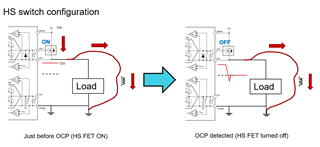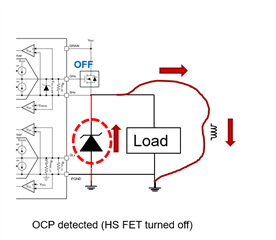Other Parts Discussed in Thread: DRV8706-Q1, , DRV8702-Q1, DRV8106-Q1, DRV8705-Q1, DRV8714-Q1, DRV8703-Q1
Tool/software:
DRV8702-Q1, DRV8703-Q1, DRV8106-Q1, DRV8705-Q1, DRV8706-Q1, DRV8714-Q1, DRV8718-Q1
Gate driver can be used as high side switch configuration. If load is motor/solenoid such as inductive load, surely must have (shottky) diode on low side to support low side recirculation.
However, even if not inductive load such as resistive load(e.g Seat heater resistive load) or load switch use case, normally need to have (shottky) diode on the low side. Otherwise negative spike could happen on SHx pin then DRV could be damaged.
Here is extreme worst case.
Customer may have load short test to GND. Then long wire could have some inductance. When output is shorted while FET is ON, current will increase until hitting VDS over current protection level. Right after FET turn off, wire practice inductance had the charged energy. The inductance tries to keep flowing current. This generates the negative voltage on SH pin then DRV could be damaged.
Here is mechanism and bench test example. 2) is the case for output short test.


Very common solution is adding (shottky) diode on low side as bellow.

-Same scenario could happen by just turn on/off HS FET by PWM operation. Overcurrent protection is just worst case. 1) wave form condition has wire between resistive load and PCB of DRV. It has parastic inductance. Therefore negative spike happens by turning off FET.
-Same senario could happen for Low side switch configuration without (shottky diode) on high side. Then positive spike could happen on SH pin.

